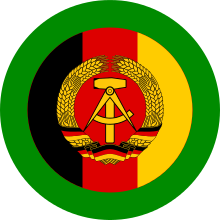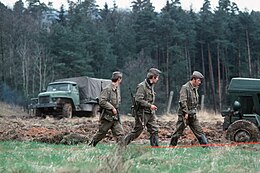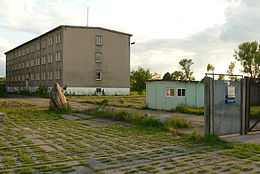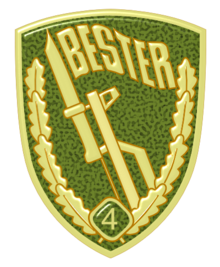Border troops of the GDR
The border troops of the GDR were a military formation subordinate to the Ministry of National Defense (MfNV) to secure and monitor the state border of the GDR . They were part of the armed organs of the GDR .
History of the border troops
The predecessor organization of the border troops of the GDR was set up on December 1, 1946, initially as a paramilitary police unit to monitor the external borders of the Soviet occupation zone (from 1949 the GDR) under the designation Grenzpolizei, from May 1952 under the designation Deutsche Grenzpolizei , based on requirements of the allied victorious powers . December 1st as the founding date was later celebrated in the GDR as border troop day. The border police / German border police were subordinate to the Ministry of the Interior of the GDR, from May 1952 to June 1953 to the Ministry of State Security (MfS). After the wall was built, the German border police were placed under the Ministry of National Defense on September 15, 1961 and the border command was established. The parts of the German border police that were involved in the identity checks at the border crossings were subordinated as passport control units to Main Department VI of the MfS. With the introduction of compulsory military service in the GDR from April 1962, conscripts were also drafted into the border troops of the GDR as part of general conscription . In October 1962, military border regiments were formed. In the spring of 1971 the border troops of the GDR were outsourced from the National People's Army ( NVA ) due to the ongoing disarmament negotiations , in order not to be counted among the country's troop strength. Nevertheless, the border troops remained directly subordinate to the Ministry of National Defense as an independent armed forces . They formed part of the armed organs of the GDR . Just like the border security forces of the other Eastern Bloc states (e.g. the Czechoslovakian Pohraniční stráž / PS ), they were based on the model of the border troops of the USSR , even if their organizational subordination differed from the Soviet model.
In 1952, the GDR border troops took over the Stintenburg mansion as a training location under the covert direction of the GDR State Security Service . Since the beginning of the seventies, the Stintenburg served as the central school for border patrols. The secrecy about this training facility was so great that the residents of the surrounding villages did not know anything about the significant influence of the Stasi until the end of the GDR. In every border company along the inner-German border in Stintenburg there were border scouts trained as professional NCOs. They had special equipment in the form of double armament with a submachine gun and a pistol, a service dog, a motorcycle, a small rake to cover up tracks; Sometimes they also brought special photo technology with them. In addition to these monitoring and control tasks, they were also responsible for maintaining contact with so-called civilian “border guards”. These were "border activists" made up of locals who had to be just as vigilant as the uniformed men at the border themselves and were supposed to report any suspicious movement or change of location. These border patrols also roamed the border towns more often. Unlike the usual border guards made up of conscripts, you were traveling alone. Between the 1980s and the time of the fall of the Berlin Wall and the peaceful revolution in 1989, the border troops of the GDR comprised an average of 44,000 people under arms.
The GDR government cultivated a good deal of distrust even towards the guards it had deployed. Particularly in relation to team ranks, precautions were taken to prevent escape plans as far as possible. Assigned to border security, they never knew, until shortly before starting work, who was to be posted with whom or to go on patrol. Under no circumstances should friendships be formed that could have resulted in escapes. Also, nobody knew whether the person on duty with him was not a Stasi spy, with the task of uncovering such projects at an early stage. The officers, whose loyalty the SED regime bought through various perks and privileges, was more reliable.
The vast majority of the troops served to guard the inner German border with the Federal Republic of Germany and the Berlin Wall , which surrounded Berlin (West) . To this day, it is still a matter of dispute how many people died trying to cross the border. The working group August 13th names 1200 deaths, the Berlin public prosecutor's office can prove 125 deaths, another 85 are investigated.
Relatively few forces controlled the Oder-Neisse border to Poland and the border to the ČSSR . The 6th Coastal Border Brigade to secure the sea border on the Baltic Sea , which organizationally belonged to the People's Navy , had a special position .
The controls at the inner-German border were officially discontinued on July 1, 1990 and the border troops were subordinated to the GDR Interior Minister for operational issues relating to control of the borders with the Czech Republic, Poland, the sea borders and the airports. The border troops were disbanded by “Order No. 49/90 of the Minister for Disarmament and Defense on the dissolution of the GDR's border troops” on September 30, 1990, and the remaining 15,000 members were released. Some of the staff was previously transferred to the GDR's border guard and from there to the Federal Border Guard (BGS) (now the Federal Police ). Around 4,500 border troops were hired by the Bundeswehr as civilian forces in recultivation commands to dismantle the inner-German border barriers. Incidentally, the border troops of the GDR and their military predecessor units had recorded a high number of complete desertions in the previous decades - in the direction of West Germany and West Berlin.
assignment
- externally: securing the territorial integrity of the German Democratic Republic
- Inward: Prevention, clarification and prevention of attempts by GDR citizens to escape, also through the use of firearms, which are described as illegal border breaches (border troop diction for " illegal border crossing ") under GDR law .
organization

The headquarters of the command of the border troops was from 1961 to 1990 in Pätz, southeast of Berlin. They were subordinate to him
- Officers college of the border troops of the GDR "Rosa Luxemburg" in Suhl (until 1984 in Plauen )
- NCO school for the border troops " Egon Schultz " in Perleberg ( service dog handler training in Wilhelmshorst )
1961 to 1971
The border command of the NVA was structured as follows from 1961 to 1971:
Six border brigades along the border with the Federal Republic
- Border Brigade 3 with staff in Perleberg
- Border Brigade 5 with staff in Kalbe (Milde)
- Border Brigade 7 with staff in Magdeburg
- Border Brigade 9 with staff in Erfurt
- Border Brigade 11 with staff in Meiningen
- Border Brigade 13 with staff in Rudolstadt
Three border brigades around Berlin (West)
- Border Brigade 1 with staff in Berlin- Treptow
- Border Brigade 2 with staff in Groß Glienicke
- Border Brigade 4 with staff in Potsdam (dissolved in 1966)
on the border with the People's Republic of Poland
- Border Regiment 18 with staff in Frankfurt (Oder) (dissolved in 1966 and divided into border battalions)
on the border with the ČSSR
- Border Regiment 19 with staff in Pirna (dissolved in 1966 and divided into border battalions )
along the Baltic coast
- Coastal Border Brigade with staff in Rostock- Gehlsdorf
Each border brigade consisted of three border regiments with two (GR-3 / GR-9 three) border battalions , nine (twelve) border companies and a training battalion .
1971 to 1989
In 1971 a reorganization took place with the introduction of three border commands:
- Border command north in Stendal
- South border command in Erfurt
- Central border command in Berlin-Karlshorst (Commander 1979–1990: Erich Wöllner )
There were also:
- Border Section Command Poland in Frankfurt (Oder)
- ČSSR border section command in Pirna
- 6th Coastal Border Brigade in Rostock
- Helicopter squadron 16 in Salzwedel , from 1986 in Nordhausen
Each border command was divided into several border regiments and one or two border training regiments. Only around 600 border guards were on duty at the borders with the “ socialist brother states ”.
The 6th Coastal Border Brigade (6th GBK) was responsible for monitoring the sea border and preventing attempts to escape across the Baltic Sea. Organizationally and operationally it was subordinate to the command of the People's Navy .
- Ensign and border reconnaissance school of the border troops , Nordhausen (district of Erfurt), from December 1985 integrated into the OHS of the border troops
Organization from 1989
Another structural change began in early 1989:
- Border district command 1 in Schwerin
- Border district command Grevesmühlen / Gadebusch
- Border district command Hagenow
- Border district command Ludwigslust
- 18 border and 2 boat companies
- Border district command 2 in Stendal
- Border district command Salzwedel / Osterburg
- Border district command Klötze
- Border district command Haldensleben
- Border district command Halberstadt / Oschersleben
- Wernigerode border district command
- 27 border companies
- Border district command 3 in Erfurt
- Nordhausen border district command
- Border district command Worbis / Mühlhausen
- Heiligenstadt border district command
- Eisenach border district command
- 22 border companies
- Border district command 4 in Sonneberg
- Bad Salzungen border district command
- Meiningen border district command
- Hildburghausen border district command
- Border district command Sonneberg / Neuhaus
- 29 border companies
- Border district command 5 in Gera
- without border district commands
- 8 border companies
- without border district commands
- Border district command 7 in Plauen
- without border district commands
- 3 border companies
- without border district commands
Border training centers in Halberstadt and Plauen , which were directly subordinate to the border command, were supposed to replace the previous border training regiments. The realization of the new border system was no longer completed due to the political upheavals.
Border Troops and the Ministry of State Security
The crew of the border crossing points (GÜSt) were members of the main department VI of the Ministry for State Security (MfS), the customs administration of the GDR (which in turn was controlled and monitored by HA VII) and members of the border troops, as well as in some cases civilian employees, such as B. Veterinarian, Red Cross, State Bank. The former belonged to departments known as passport control units (PKE) and performed their duty in the uniform of the border troops, but without belonging to them. The handling of people and goods was outside the competence of the border troops. The flanks, the border itself and the rear boundary of the GÜSt were secured by security companies (SiK) or security trains (SiZ) of the border troops.
The technical operation of the GÜSt was carried out by small special units of the border troops, such as cleaning, garbage disposal, (electricity) emergency power systems, lighting, barriers and traffic lights.
Another MfS service unit, completely legendary as a GT unit, was the radio reconnaissance of the border troops, which mainly eavesdropped on the western border area (radio traffic from NATO units and the Federal Border Guard ). These employees were stationed at the three border commandos coast, north and south and belonged entirely to main department III (radio reconnaissance). They were managed by the MfS district administrations (North, for example, by BV Magdeburg ), which also regularly picked up the tapes with recordings of the intercepted radio traffic from the GT commands.
Overall, the border troops were monitored by Main Department I of the MfS, visible as Administration 2000 or Office 2000 at the GT locations and covered with officers in special operations (OibE) in key positions and unofficial employees (IM). The border troops had the highest penetration with IM of all GDR institutions (ratio of almost one to five).
With the medal for exemplary border service , the MfNV, represented by the deputy minister for national defense and chief of the border troops of the GDR, honored border soldiers for exemplary security of the state border. A lower award was the "Achievement Badge of the Border Troops". The "Best Badge " was awarded for exemplary service and outstanding political and sporting achievements .
Chief of the border troops
(including predecessor in the German border police)
- 1952 Chief Inspector Richard Smolorz
- 1952–1955 General Inspector or Major General Hermann Gartmann
- 1955–1957 Colonel Heinrich Stock
- 1957 Major General Hermann Gartmann
- 1957–1960 Major General Paul Ludwig
- 1960–1979 Colonel General Erich Peter
- 1979–1990 Colonel General Klaus-Dieter Baumgarten
- 1990 Major General Dieter Teichmann as Head GT / Head of Border Security
Wall rifle trials
Since the wall was built on August 13, 1961, at least 756 people have died trying to cross the border illegally. 271 of them were killed on the inner-German border. There were 239 deaths on the Berlin Wall itself. 174 died on the maritime border on the Baltic Sea and 41 GDR citizens died on the border between the Federal Republic of Germany and the Eastern Bloc countries. Among the dead were 5 deserters from the GSSD and 16 members of the border troops. After the fall of the Wall, members of the border troops were sentenced to long prison terms in the wall rifle trials (because of the fatal shots at the Berlin Wall and the inner German border and because of the order to shoot ). Among them was the former head of the group, Klaus-Dieter Baumgarten .
literature
- Peter Joachim Lapp : Front service in peace - the border troops of the GDR. Development structure tasks. 2nd Edition. Koblenz 1987, ISBN 3-7637-5349-4 .
- Peter Joachim Lapp: Combat service in peace. The border regime of the GDR 1945–1990. Bonn 1999, ISBN 3-7637-5992-1 .
- Dietmar Schultke : Nobody gets through. The history of the inner-German border 1945–1990. Berlin 1999, ISBN 3-7466-8041-7 .
- Dietmar Schultke: The border that divided us - eyewitness reports on the inner-German border. Berlin 2005, ISBN 3-89574-565-0 .
- Volker Koop : marginalized. The fall of the GDR border troops . Berlin 1996, ISBN 978-3-89488-064-4 .
- Jürgen Ritter, Peter Joachim Lapp: The limit. A German building . 9th edition. Berlin 2015, ISBN 978-3-86153-560-7 .
- The Federal Commissioner for the Records of the State Security Service of the Former German Democratic Republic (ed.): Escape from the GDR using the example of “Two schoolchildren attempted to break through the border”, excerpt from an MfS file. BStU for schools. Sources for School 2, 2nd, corrected edition, Berlin 2008 ( PDF ).
- Peter Joachim Lapp: Border regime of the GDR. Aachen 2013, ISBN 978-3-86933-087-7 .
- Peter Joachim Lapp: Officers' college "Rosa Luxemburg". Cadre forge of the GDR border troops. Aachen 2014, ISBN 978-3-86933-113-3 .
- Jochen Maurer: Stop - state border !. Everyday life, service and inside views of the border troops of the GDR . Ch. Links Verlag, Berlin 2015, ISBN 978-3-86153-863-9 .
- Peter Joachim Lapp: Border Brigade Coast. GDR border security at sea , Aachen 2017, ISBN 978-3-86933-182-9
- Wolfgang Karge: Stintenburg im Schaalsee: manor, refugee camp, border barracks and central school of the MfS for border scouts , Schwerin, 2019 ISBN 978-3-933255-56-3 .
See also
Web links
- Detailed explanation of the history and structure of the border troops of the GDR
- one day, contemporary stories on Spiegel online border security in the GDR, "The blow has sat" with further links to original film material from the time before 1989
- The border troops - border scouts in the border troops
- Overview of the border security units on a private website ddr- Grenztruppen.de
- Stasi media library, collection of documents: border troops of the GDR
- BStU , topic: Kaderschmiede in the "border district": Stasidurchsetzt - the officers' college of the GDR border troops in Suhl
Individual evidence
- ^ Rainer Blasius : GDR and the military, ready for action in the front-line state in Faz-Online from September 18, 2011
- ↑ Conscription Act of the GDR
- ^ "Stintenburg secret matter, when the GDR State Security trained an elite troop in the middle of idyllic Schaalsee" FRANKFURTER ALLGEMEINE SONNTAGSZEITUNG, AUGUST 4, 2019, NO. 31, page 3
- ↑ Jürgen Ritter, Peter Joachim Lapp : Germany without borders: Images of the German-German border - then and now , p. 12
- ^ Hans Hermann Hertle: The Berlin Wall / The Berlin Wall. Cold War Monument. Federal Agency for Civic Education, Bonn 2009
- ↑ Ulrich Bröckling (Ed.): Armies and their deserters: neglected chapters of a modern military history. Vandenhoeck & Ruprecht, Göttingen 1998, ISBN 3-525-01365-5 ; Rüdiger Wenzke: The desertion in the armed forces of the GDR. P. 252 ff.
- ↑ Law on the State Border of the German Democratic Republic of March 25, 1982, repealed by the Unification Treaty of August 31, 1990 (Federal Law Gazette II. P. 889)
- ^ Peter Joachim Lapp: The border troops of the GDR (1961-1989) in Hans Ehlert, Rüdiger Wenzke (Ed.): In the service of the party - Handbook of the armed organs of the GDR , Berlin, 1998 p. 248






